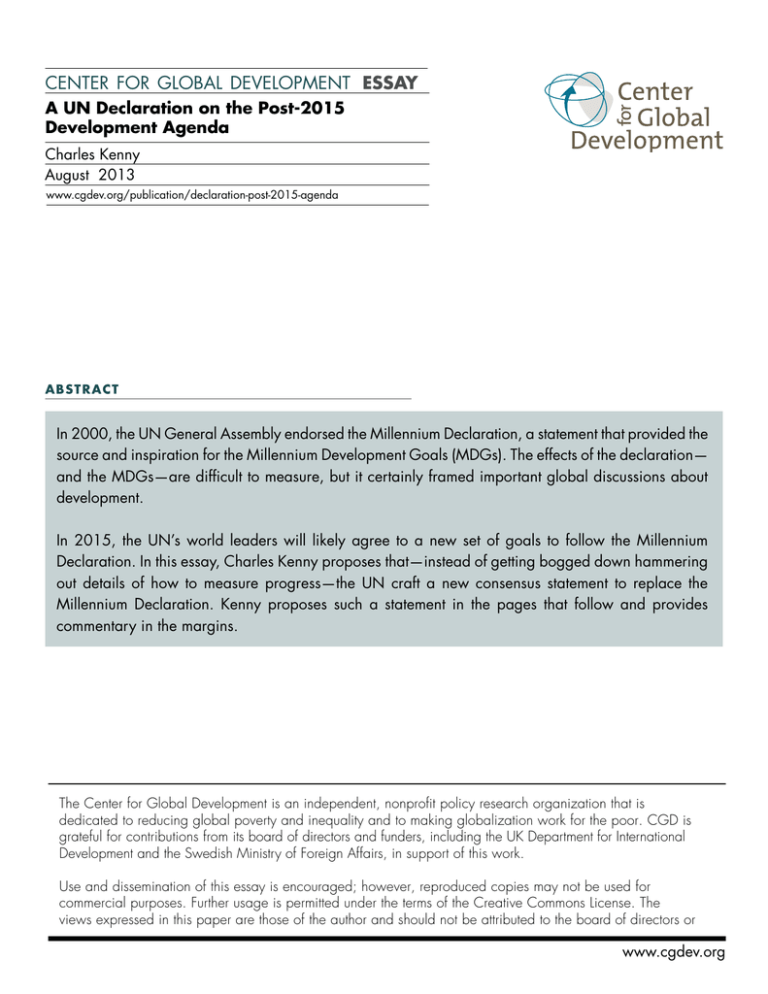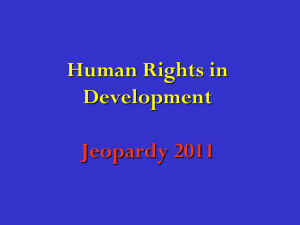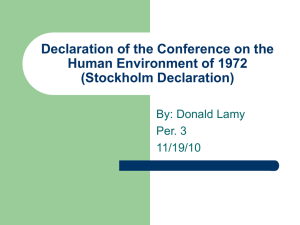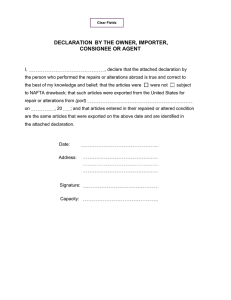center for global
advertisement

center for global development essay A UN Declaration on the Post-2015 Development Agenda Charles Kenny August 2013 www.cgdev.org/publication/declaration-post-2015-agenda abst r a c t In 2000, the UN General Assembly endorsed the Millennium Declaration, a statement that provided the source and inspiration for the Millennium Development Goals (MDGs). The effects of the declaration— and the MDGs—are difficult to measure, but it certainly framed important global discussions about development. In 2015, the UN’s world leaders will likely agree to a new set of goals to follow the Millennium Declaration. In this essay, Charles Kenny proposes that—instead of getting bogged down hammering out details of how to measure progress—the UN craft a new consensus statement to replace the Millennium Declaration. Kenny proposes such a statement in the pages that follow and provides commentary in the margins. The Center for Global Development is an independent, nonprofit policy research organization that is dedicated to reducing global poverty and inequality and to making globalization work for the poor. CGD is grateful for contributions from its board of directors and funders, including the UK Department for International Development and the Swedish Ministry of Foreign Affairs, in support of this work. Use and dissemination of this essay is encouraged; however, reproduced copies may not be used for commercial purposes. Further usage is permitted under the terms of the Creative Commons License. The views expressed in this paper are those of the author and should not be attributed to the board of directors or www.cgdev.org A UN Declaration on the Post-2015 Development Agenda In 2015, assembled presidents and potentates at the United Nations in New York will (probably) agree to a follow-on to the Millennium Declaration. That declaration, endorsed at the UN in 2000, provided the source and inspiration for the Millennium Development Goals (MDGs). It is hard to know exactly what difference was made by a legally toothless nonbinding statement of various things that world leaders agreed were good (“uphold the Olympic truce”) and aspirations for progress over the next fifteen years (“everyone completes primary school”). But the Millennium Declaration and the Goals may have further cemented norms about things that mattered—and they certainly helped frame global discussions about development. In turn, that might have made a difference to the direction and pace of global development over the years that followed. Or, at least, the evidence is not inconsistent with that view—as Andy Sumner and I argued in our paper “More Money or More Development: What Have the MDGs Achieved?”1 Recent thinking around the post-2015 development agenda has focused on the goals and targets of a follow-on set of MDGs for the period 2010–2030. These are important discussions that have clarified potential areas for goals and the plausibility of particular targets. But another approach to the post-2015 agenda is to think about what would replace the Millennium Declaration itself—after all, that is how the process worked last time. One big benefit of the approach of leading with the declaration is that the diplomats and world leaders at the UN General Assembly could spend their time considering the broad framework for progress over the 2010–2030 period rather than getting bogged down in technical issues of how to measure progress in specific, plausible, numerical, and time-bound indicators across all areas. Just like in 2001, a detailed goal- and target-setting process could follow on from a new declaration that provided the framework. And as with the original MDGs, that process could be delegated to technical working groups of the UN in the year after the declaration. What follows is a proposal for the draft text of such a declaration—with comments from me on the side. Where specific time-bound targets are included in the language, they are largely based on projections from “MDGs 2.0: What Goals, Targets and Timeframe,” by Andy Sumner, Jonathan Karver, and me—where an earlier version of this declaration appeared.2 Much of the global partnership language is lifted from a paper with Sarah 1 Charles Kenny and Andy Sumner, “More Money or More Development: What Have the MDGs Achieved?” CGD Working Paper 278 (Washington: Center for Global Development, 2011), http://www.cgdev.org/publication/more-money-or-more-development-what-have-mdgs-achieved-workingpaper-278. 2 Jonathan Karver, Charles Kenny, and Andy Sumner, “MDGs 2.0: What Goals, Targets, and Timeframe?” CGD Working Paper 297 (Washington: Center for Global Development, 2012), http://www.cgdev.org/publication/mdgs-20-what-goals-targets-and-timeframe-working-paper-297. 1 Dykstra, “The Global Partnership for Development: A Review of MDG 8 and Proposals for the Post-2015 Development Agenda.”3 And the idea for development ideals comes from my forthcoming paper with Lant Pritchett, “Promoting Millennium Development Ideals: The Risks of Defining Development Down.”4 3 Charles Kenny and Sarah Dykstra, “The Global Partnership for Development: A Review of MDG 8 and Proposals for the Post-2015 Development Agenda,” CGD Policy Paper 26 (Washington: Center for Global Development, 2013), http://www.cgdev.org/publication/global-partnership-development-review-mdg-8-andproposals-post-2015-development-agenda. 4 Lant Pritchett and Charles Kenny, “Promoting Millennium Development Ideals: The Risks of Defining Development Down,” CGD Working Paper (Washington: Center for Global Development, forthcoming). 2 Continuing the Commitment to the United Nations Millennium Declaration I. Values and principles 1. We, heads of State and Government, have gathered at United Nations boilerplate Headquarters in New York in September 2015, to reaffirm the values and commitments laid out in the United Nations Millennium Declaration, to highlight the ideals of development to which all have the right to aspire, and to set new goals for development progress to guide international efforts over the next fifteen years. 2. We reaffirm our faith in the United Nations and its Charter as indispensable foundations of a more peaceful, prosperous and just world and our collective responsibility to uphold the principles of human dignity, equality and equity at the global level. We remain determined to establish a just and lasting peace all over the world in accordance with the purposes and principles of the Charter. We highlight the centrality of the rights enshrined in the Universal Declaration of Human Rights in promoting human dignity and welfare. And we stand firm in our commitment to the fundamental values essential to international relations in the twenty-first century: freedom, equality, solidarity, tolerance, respect for nature and This declaration is largely about goals and targets for progress. These are different from human rights, which are timeless and universal. But it is important that a post-2015 declaration not appear to weaken or downplay global commitment to the full range of human rights. That’s what heads of state and government said in 2000. Hopefully they’ll do better this time. shared responsibility. II. Progress on sustainable development and poverty eradication 3. We recognize the considerable global progress that has been achieved towards the goals for development laid out in the Millennium Declaration. In particular we celebrate the global success in more than halving rates of absolute poverty worldwide. Notwithstanding that achievement we recognize progress has been less rapid than hoped at the global level in other areas of development and rates of progress varied considerably across and within countries. Fifteen years into the new millennium, too many children, women and men worldwide remain suffering lives of unconscionable deprivation. 3 Acknowledgement that many of the MDGs will have been missed at the global and country level. 4. While recognizing countries will see differing rates of progress across different areas of development, and that countries will have different These goals include broad language suitable for framing discussions over development at all income levels. priorities for their own path to development, we resolve: To continue progress towards the eradication of poverty and hunger worldwide and to ensure that, by the year 2030: less than three percent of the world’s population lives on less than Not quite the zero target of the High Level Panel, but instead the near-zero of the World Bank. $1.25 a day; the proportion of the world’s people whose income is less than two dollars a day or that is undernourished is below one in ten, and that a minimum of 500 million additional people are in decent paid employment. To promote long and healthy lives worldwide, make progress towards wiping out preventable child and maternal mortality and, by 2030, to have increased global average life expectancy to 75 years; reduced global maternal mortality to below one per thousand births; and reduced global under-five child mortality to half its level in 2010. To accelerate progress for all towards improved mastery of language, writing, math and science skills required for a productive role in national and global societies and guarantee that, by 2030, all children will complete primary school with a mastery of basic literacy and numeracy. Again, most time-bound 2030 globaltarget language is based on ambitious but plausible improvements over business as usual, rather than zero goals that would set up some countries for failure—particularly in Africa. Note that some are global average targets and some are global progress targets. Most targets in this draft are based around forecasts of plausible rates of improvement, this one is just made up. There isn’t enough data to know with any certainty that this is a plausible target—but we do know we are a long, long way from it today. To make broad-based progress on ensuring equality of opportunity regardless of gender, race, ethnicity or sexual orientation and have, by 2030, halted, and begun to reverse, trends towards greater population disparities in the number of girls and boys at age five in every country where such trends have been manifest. These are estimates based on progress a bit better than business as usual, but the jobs estimate uses particularly ropey data. To extend access to modern sustainable infrastructure and by 2030, to have ensured universal access to information and communications technologies as well as to electric lighting; 4 The High Level Panel report suggests as a gender target no violence against women or girls by 2030. It does not suggest how this might be accomplished. Having said that, gender disparity is hardly all that matters in terms of targets and is irrelevant to many countries. There is a lot of heavy lifting here for the UN technical working groups and national processes that would follow on from the declaration to build a full list of goals, targets and indicators. and extended access to decent housing, transport, improved water and sewage facilities, electricity, and clean cooking technologies. 5. We resolve in addition to ensure that progress towards these goals across and within countries is more rapid amongst those groups currently most disadvantaged—to promote a convergence towards the top in the national and global quality of life. 6. We reiterate that civil and political rights including democratic and participatory governance, security and the rule of law are all ends of development in and of themselves as well as vital inputs to broad based progress. In order to ensure the benefits of citizenship to all, we resolve that, by 2030, all children worldwide are registered at birth and legally identified. In order to promote more efficient and responsive government we resolve that all national and local governments worldwide should A commitment to convergence in the quality of life across and within countries is meant to be a potentially politically acceptable alternative to an inequality goal. No specific targets on democracy (forget opposition from China or Saudi Arabia—what indicator would the United States accept when it can’t even figure out if Egypt had a coup in July). At the same time, here is a reiteration of the importance of democracy, and some specific governance targets around inclusion and transparency. publish and make freely available detailed information on taxation and revenues, budgeting, expenditures and contracts collected and executed on behalf of citizens. 7. We celebrate the global trend towards reduced violent crime and conflict and reiterate our commitment to peaceful resolution of disputes War and violence deserve a mention, and highlighting domestic violence is important—but no target. between and within countries. We repeat our call for the elimination of weapons of mass destruction, particularly nuclear weapons, and for countries to take concerted action to end illicit traffic in small arms and light weapons, especially by making arms transfers more transparent and supporting regional disarmament measures. We commit ourselves to further efforts to reduce the global burden of violence in accordance with the Geneva Declaration on Armed Violence and Development. We deplore the continuing global scourge of domestic violence and commit to redoubled efforts to combat it. 8. We commit to a world of sustainable consumption in which every generation lives within planetary boundaries. We resolve, by 2030 to have: reversed the global trend towards deforestation; at least doubled the 5 Olympic truce language from original declaration has been dropped, replaced with language about by far the most common form of violence worldwide. Strong global climate targets but nothing that wasn’t (effectively) agreed at Cancun and Copenhagen. Biodiversity language lifted from the 2010 Nagoya Summit. renewable share of global energy production; halted (by 2020) and reversed growth in global greenhouse gas emissions; ensured areas worldwide used for agriculture, aquaculture and forestry as well as all fish stocks are managed sustainably; and prevented the extinction of known threatened species. 9. Furthermore, we emphasize that completing the struggle against absolute deprivation is only the first step towards a high and sustainable quality of life for all. It is the justifiable aspiration of the vast majority of humanity that they should enjoy an income at least high enough to surpass the national poverty lines of industrialized countries, and the health, educational and broader quality of life outcomes associated with that. All of the world, not just those in the industrialized countries, should reasonably aspire to a level of income above $15 a day; to the expectation of a long and healthy life free of easily preventable mortality or undue financial burdens from healthcare; to a level of education that allows for full engagement in a globalized economy as well as political and cultural discourse; and to infrastructure such as quality housing, indoor plumbing, This paragraph and the next introduce development ideals—statements regarding justifiable aspirations for quality of life worldwide. These go alongside a reaffirmation of the centrality of the Universal Declaration of Human Rights in promoting human dignity and welfare. Goals and targets are designed to measure development progress over a time-bound period. They should not be confused with timeless and universal rights and aspirations. The previous paragraph introduced planetary boundaries, these two suggest the global floor. Between the two they delineate a version of Kate Raworth’s “global donut economy”— the safe and just space for humanity in which the world’s population should live. electricity, modern cooking facilities and quality public transport. 10. People in all countries should have access to decent employment alongside equal and full recourse to public services, justice and the rule of law as well as an effective government that guarantees the universal rights of the United Nations declaration. People everywhere should be to be secure from violence, discrimination and social exclusion; and should live in an environment which provides clean water and air, safe and nutritious food, and biodiversity. All should have time for leisure and relaxation. No country should see gross inequalities in income or other measures of the quality of life. And people in every country should enjoy social protection in the case of misfortune. We declare that development will be incomplete until these aspirations are universally and sustainably met, and these are the development ideals towards which we as a global community will strive. 6 As they won’t be by 2030, that means we should start preparing for negotiations over the post-2030 development agenda. III. A global partnership for sustainable development 11. Sustainable development is achieved through working collectively – through the private sector, civil society, governments and international institutions. The primary capacity for delivering on development targets and making progress towards development ideals lies at the national level. 12. In order to release additional resources for the achievement of Having the United Nations declare a set of development targets is first and foremost about framing the engagement of the global community when it comes to delivering on sustainable development. For the post2015 agenda to have (more) value, it needs to lay out specific things that the global community is going to do differently in order to meet the goals That’s based on continuing the trend sustainable development, we resolve to reduce global military expenditure of the last twenty years. Domestic resources and actors will carry the largest burden in every country. But there is a vital role for global engagement and cooperation to sustain progress –through finance, trade, migration, the exchange of ideas and technologies and cooperation on global public goods from environment through health. Regional and global agreements and partnerships –and the United Nations family in particular—will be of central importance in the effort to meet sustainable development goals. expressed as a proportion of global output by one third between 2010 and 2030, and to substantially increase funding for global public goods including the fight against infectious diseases, technologies for sustainability, biodiversity and fisheries protection, climate change and peacekeeping. High-income countries will make progress towards the target of 0.7% of Gross Domestic Product in overseas development assistance. We resolve further that, between 2020 and 2030, high income countries should finance the additional incremental efficient costs of interventions that cannot reasonably be met by domestic resources to ensure no person lives on less than $1.25 a day and avoidable child and maternal mortality is prevented, with payment made on the basis of The rational basis for 0.7% doesn’t really exist, but it has become an important benchmark. And, if anything, the level of global transfers and payments for the upkeep of global public goods should be much higher. This is to tie aid flows to progress on development goals far more specifically than in the original MDGs. It proposes cash-on-delivery assistance for countries who make more rapid than expected progress in goal areas. verified progress. We reiterate the principles laid out in the Busan Declaration and elsewhere regarding the importance of coordination, transparency and the use of country systems to effective development assistance. 13. We recommit to global agreements through the World Trade Organization as the most effective tool to increase the development 7 Global development, and global engagement, is primarily about trade, investment, migration and technology alongside protection for the global commons. The next paragraphs lay out targets in all of these areas. impact of trade. We will complete progress towards G-20 duty-free quotafree access for least developed countries and as a global community we universally commit to duty-free, quota-free access for goods from least developed countries by 2020. We will work together at the World Trade Organization towards a new agreement that reduces non-tariff barriers to Now that developing countries account for more than half of world trade, it isn’t enough to have duty-free, quotafree just from rich countries. trade including harmonized standards on goods and services that can be traded in particular covering phytosanitary and technical barriers to trade, rules of origin and the movement of people as part of trade. 14. We will work towards greater stability in global financial flows and lower risk of financial crises through cooperation at the International Monetary Fund including increased quota contributions especially from This is ongoing, although it needs to go further. economies that are responsible for an increased proportion of global output. We will ensure international public debt terms are public and transparent. We commit to a strong global agreement on tax avoidance and tax transparency, including a requirement for corporations to publish taxes paid in each tax jurisdiction in which they operate. We commit Language not quite agreed at the recent G-8 meeting. further to a global agreement on tax credits for foreign taxes paid. 15. We recognize the importance of cross-border movement of people to broad-based development and we commit to facilitating that movement both with regard to temporary and permanent relocation, including the strengthening of global institutions that support such facilitation. We commit to work towards agreeing stronger international standards governing professional and technical qualification to improve the portability of skills worldwide. 16. Recognizing the role of technology in development and protecting the global commons, we commit to extend the World Trade Organization lowincome Trade Related Aspects of Intellectual Property Rights compliancy transition period until 2030. We will work towards a global agreement on simplification and harmonization of clinical trial procedures and approval of new crop varieties and foods. And we will support global efforts to 8 A mere statement that migration is an important force for development would be a new step for the UN. combat infectious disease and reduce the spread of antibiotic-resistant bacterial infections. Infectious disease remains the most urgent global public health priority. 17. Recognizing the common but differentiated responsibilities we bear towards preserving the global environmental commons, industrialized Fund to mobilize $100 billion annually to assist with climate mitigation This is the commonly accepted but not (yet) official target for the fund, created at the Cancun UNFCCC. and adaptation. The Group of Twenty nations will eliminate all fossil fuel Already agreed by the G-20. countries will provide $10 billion a year to establish a Green Climate subsidies by 2020. 18. In order to strengthen the capacity and credibility of international organizations, we commit to an open, merit-based appointment system regardless of race, creed, sex or nationality throughout United Nations Probably the least politically plausible target proposed in this draft. system at all levels. We will engage in ongoing voting reform at international financial institutions to better reflect the changing global economy, and membership reform at the United Nations Security Council to better reflect representation of the world’s people. 19. We commit that all signatories will provide to the Secretary General, within eighteen months of this declaration, plans outlining national commitments towards meeting the global goals aspirations and responsibilities laid out in the declaration. We ask the Secretary General to issue a report on the basis of these plans regarding the extent to which aggregated national commitments are sufficient to meet the goals, responsibilities and aspirations. We call on the Secretary General and United Nations agencies and programs to propose indicators and oversee implementation of data collection on areas where measurement of proposed goals and targets is weak or partial. We request the General Assembly to review on a regular basis the progress made in implementing the provisions of this Declaration, and ask the Secretary-General to issue periodic reports for consideration by the General Assembly and as a basis for further action. 9 Probably the second least politically plausible target proposed in this draft. The process of member states creating their own commitments should increase national ownership and relevance across economy types alongside the utility of the development goal process for civil society to hold individual governments to account.






